If you live in the Western world, you’ve most likely been struggling with your weight at some point in your life. It is estimated that 2 out of 3 Americans are overweight or obese and other, even less developed, countries seem to follow this trend.
Even though doctors and the media have been trying to help us shed some excess pounds, it’s somehow not working. Their mantra is that we should “eat less and move more.”
If this led to sustainable weight loss, we would never struggle while being on restrictive diets and be already thin by now. But we need enough food to get through the day. So how can we eat a lot and still lose weight?
Unfortunately, many diet plans focus on restrictions and use guidelines such as “just cut calories”, “don’t eat carbs” or “reduce your portions”.
However, it has been shown that adding foods that are low in calorie density is the best strategy for losing weight – not just eating less overall.
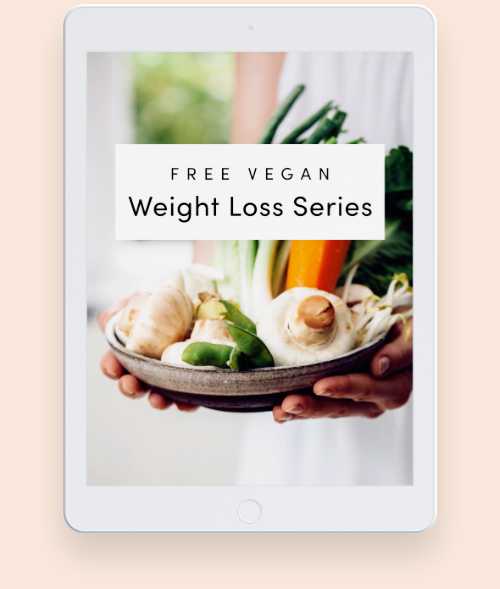
free weight loss email series
Getting lean while feeling full? Yes, that’s possible! Find out about easy food swaps, calorie density and 3 full days of eating for sustainable weight loss.
Long-term studies on low calorie dense diets have shown that those who made the greatest reductions in the calorie density of their diets lost the most weight. They also consumed the most volume and weight of food, which helped them to control hunger and kept them satisfied.
Overall, these participants ate the healthiest diets which naturally consisted of high amounts of fiber, vitamins, and minerals, and only small amounts of saturated fat.
So they ate more food, were more satisfied, lost more excess weight, and lowered their disease-risk without restricting or counting calories. It almost sounds too good to be true!
Eater smarter, not less, is the solution to weight management!
The secret to these results starts with the principles of calorie density. So let’s take a closer look and see how to eat a lot and still lose weight.
What Is Calorie Density?
Calorie density is simply a measure of the concentration of calories in a particular food. The higher the calorie density, the higher the concentration of calories packed into the food bite for bite.
This can be helpful to roughly estimate the amount of calories that are on your plate but also to learn which foods to emphasize to reach your weight goals.
Coincidentally, foods that are low in calories are also generally rich in essential nutrients and lead us to good health. This doesn’t mean that all calorie dense foods are very unhealthy, as you will see later, but they tend to cause you to overeat as they pack a lot of calories into each bite.
It’s our natural tendency to reach for the calorie dense foods (an evolutionary survival mechanism) and our brains also reward us more for snacking on chocolate compared to an apple. It’s less chewing and digesting for more energy!
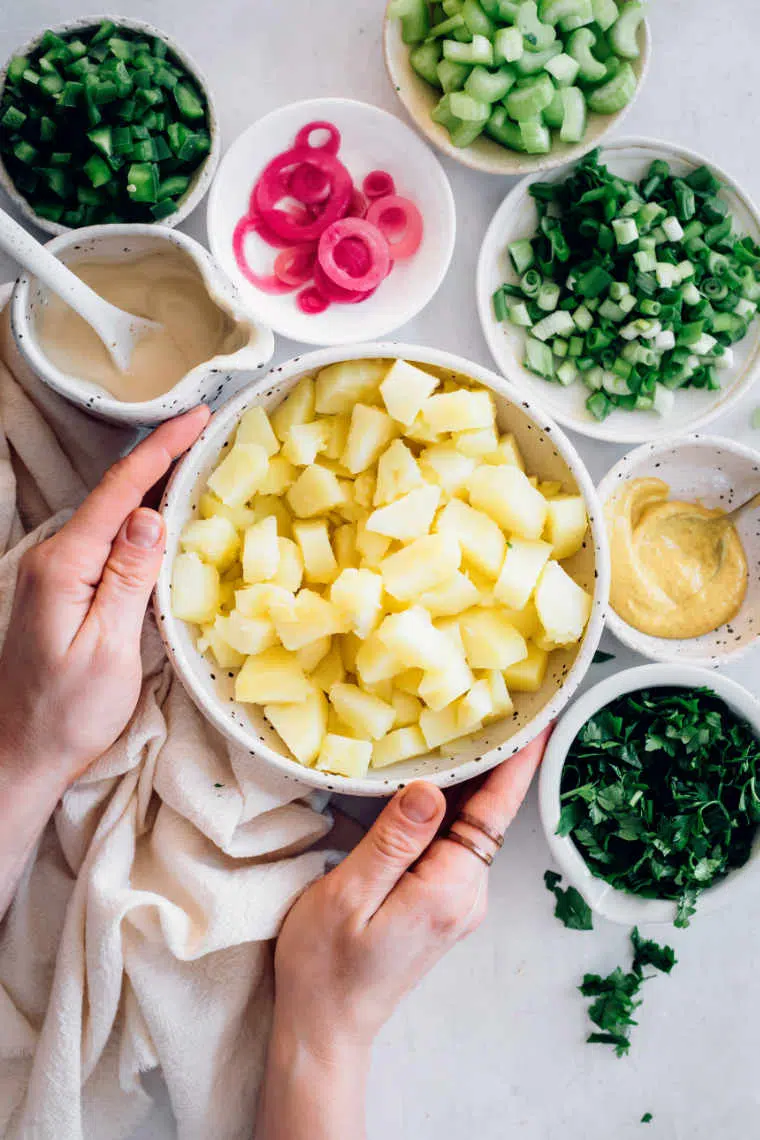
General Compositions
Foods that are low in calorie density, like fruits, vegetables, whole grains and legumes, don’t pack a lot of calories per bite. Their molecular composition allows you to fill up on them while unintentionally eating fewer calories – therefore, losing weight without going hungry. This is because they are
- High in fiber
- High in water
- Low in fat
On the other hand, foods that are high in calorie density, like processed food or animal-based food, are stuffed with lots of calories per bite while offering very little bulk or volume – which can easily lead to an overconsumption of calories. This is because these foods are generally
- Low in fiber
- Low in water
- High in fat
- High in added sugar
As you can see, there are some key factors that make a food high or low in calorie density and therefore generally better or worse for weight loss and healthy weight maintenance.
Full Weight Loss Guide →The 4 Categories of Calorie Density
If all of this sounds a bit confusing and unclear to you at this point, no worries. We created four different categories that help you remember the approximate calorie density of a specific food.
It’s a hands-on approach to this fantastic scientific concept and you can use the categories to easily create weight loss-friendly meals.
1. Low Calorie Density
All fruits and vegetables, such as apples, bananas, berries, kale, zucchini, and bell peppers. Exceptions: dried fruit and fruit juice where the fiber and water content have been manipulated. You can eat freely from these foods if you want to lose weight.
2. Moderate Calorie Density
All starchy vegetables like potatoes, peas and corn as well as intact whole grains like brown rice and oats, and legumes like beans and lentils. You can eat a relatively large portion of these foods, we recommend they take up around 30-50% of your plate for weight loss.
3. High Calorie Density
Slightly processed plant-based foods like bagels, dry cereal, bread, tortillas, and dried fruit. (Meat and cheese would be in this category as well but please read below why we don’t recommend any animal products.) Limit the consumption of these foods.
4. Very High Calorie Density
Nuts and seeds, oils and fats, chocolate, and junk foods. Greatly limit or avoid the consumption of these foods. Please note: This doesn’t mean that nuts and seeds are unhealthy, they are just high in calories.
The first 2 groups (low and moderate in calorie density) should make up the majority of your calorie intake. But the ratio of vegetables or fruits to starches can also be an important factor.
We all know that eating a large bowl of lettuce might fill up your stomach, but it will keep you hungry at the same time. So make sure to combine your low calorie dense foods with some starches from the second category to feel satiated and have enough energy to go about your day.
This graphic by Forks Over Knives illustrates how full you’ll feel after 500 calories of different foods:
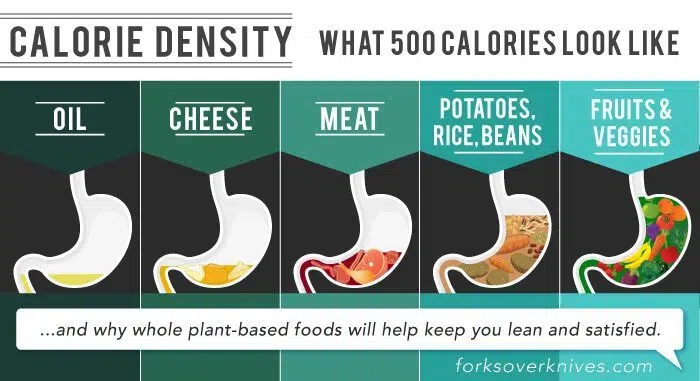
What About Animal Products?
You might have noticed that we didn’t include any animal products in our 4 different categories of calorie density. However, you can see in the graphic above where they would fall on the scale.
In general, we don’t recommend anyone eat any animal products for various reasons – and even if you’re not concerned about the ethical or environmental issues, you might be interested to learn that animal protein has been positively associated with weight gain.
Dairy products are the number one source of dietary fat in the Western world (something we surely don’t need more of) and there are even morphine-like molecules in dairy that keep us coming back for more food.
Looking at animal products from a biochemistry perspective, they don’t fit any of the criteria to make them calorie density friendly (such as having fiber) and are comparably high in fat. Gram per gram, fat has more than twice the calories than protein or carbs which makes fatty food so calorically dense.
These are some of the reasons why we’d recommend you switch to bean burgers or vegan mac and cheese – more fiber, easier weight loss, better for the animals and the planet. Why not give it a try?
You can start by making some easy and delicious weight loss-friendly food swaps or get a free 3-day meal plan in our free plant-based weight loss series!
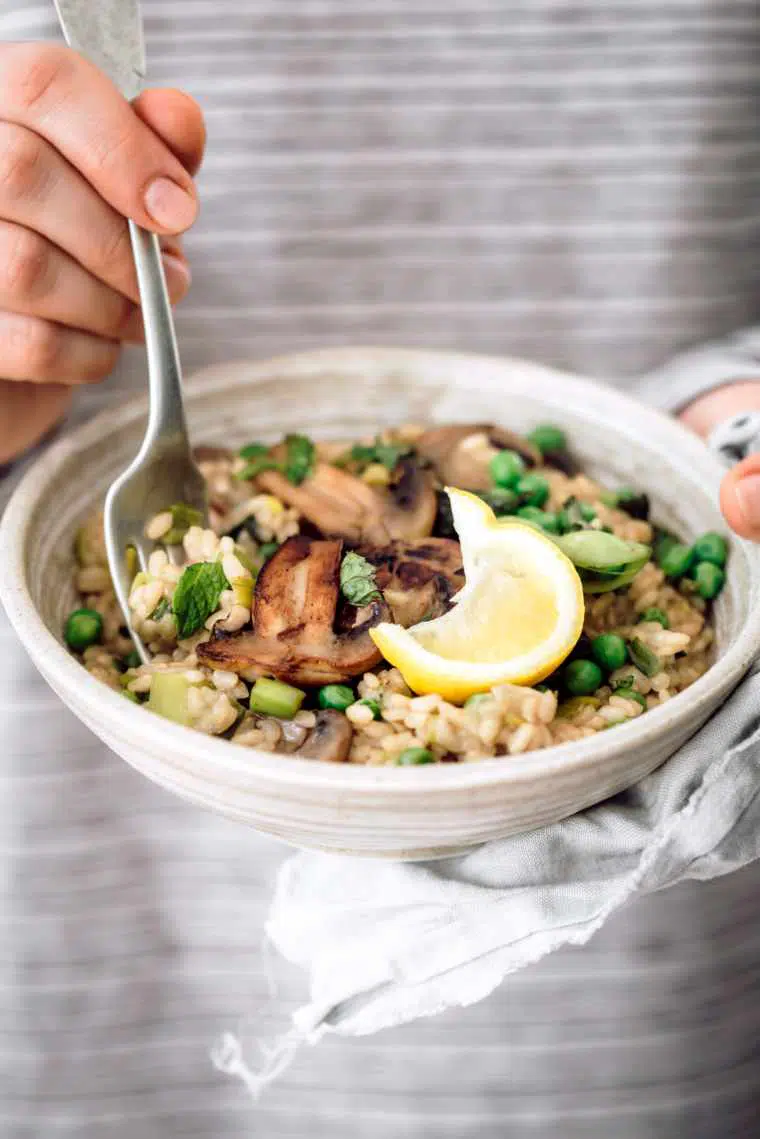
6 Real-Life Eating Tips for Weight Loss
Now, we want to break all of this down into some actionable steps for you. Although the overall message is to just eat more of the low calorie density food and cut out or reduce the ones that are very high in calorie density, different small shifts can help you get there.
1. Hunger & Satiety
Whenever you are hungry, eat until you are comfortably full and choose food lower in calorie density. Don’t starve or stuff yourself, and don’t eat when you’re not hungry. Likewise, don’t let yourself get too hungry because you’re more likely to overeat or eat junk food in these situations.
2. Sequence Meals
Start all meals with a salad, soup or fruit. These foods will already partially fill your stomach and lower the overall calorie density of your meal, whatever you choose to eat afterward. This allows you to eat a lot but still lose weight!
3. Don’t Drink Your Calories
Liquid calories like soft drinks or even fruit juice offer little if any satiety, so they don’t fill you up as much as solid foods with the same amount of calories. Even fruit smoothies could hinder your weight loss if they consist of more fruit than you could eat hadn’t it been blended up.
4. Create a Smart Ratio
Dilute the calorie density of your meals by filling at least half your plate (by visual volume) with some food lowest in calorie density, which are non-starchy vegetables and fruits.
5. Keep the Categories in Mind
Non-starchy vegetables have the lowest and oils have the highest calorie density. Therefore, adding non-starchy vegetables to any dish will always lower the overall calorie density of a meal. Consequently, adding fat or oil to any dish will always raise the overall calorie density of a meal.
6. Limit High Calorie Dense Food
If you use flour products or nuts and seeds, integrate them into meals that are made of low calorie dense foods and think of them as condiments. For example, add a few walnuts or raisins to a bowl of oatmeal with fruit.
Weight Loss Beginner Recipes
Now, what to do with all of this information? Our website is full of weight loss-friendly and approachable beginner recipes that truly nourish you and make losing weight a breeze.
Here are some of our favorite choices you can start with or just take a look around yourself and make some plant-based goodness to eat a lot and still lose weight!
Why We Love Calorie Density
On top of losing weight easily, the calorie density approach ensures you’re getting a solid amount of micronutrients like vitamins and minerals, which reduce cravings as well as the risk of developing most chronic diseases.
While you should try to consume a lot of calorically dilute foods like fruits, vegetables, legumes and whole grains, make sure you get enough calories at the same time, aiming for at least 1500 calories per day (for an average female adult).
Accidentally undereating can happen quickly when you switch to a diet high in produce and low in fat, so you might want to track your intake for the first few days.
Furthermore, we want to emphasize that calories are not evil. They fuel your body and are necessary for survival. Having to count them is an inconvenient task and often inaccurate – the source where the calories come from matters greatly in the grand scheme of things.
Some foods are completely devoid of nutrition and offer lots of harmful components, while others are bursting of micronutrients. To make things easier for you, we wanted to show you these 4 categories so you can stop counting and start filling your belly!
Vegan Nutrition Guide + Download →It would be a lie to tell you “just eat whatever you want and you’ll be thin” because this is not the case. If you want to lose weight and see good results, you have to make smart choices and not over-complicate things.
The key to a healthy and lean body is to eat as much as you want of mostly nutrient-rich foods – the rest will just fall into place. Therefore, we encourage you to embrace these low calorie dense foods and see if it makes any difference.
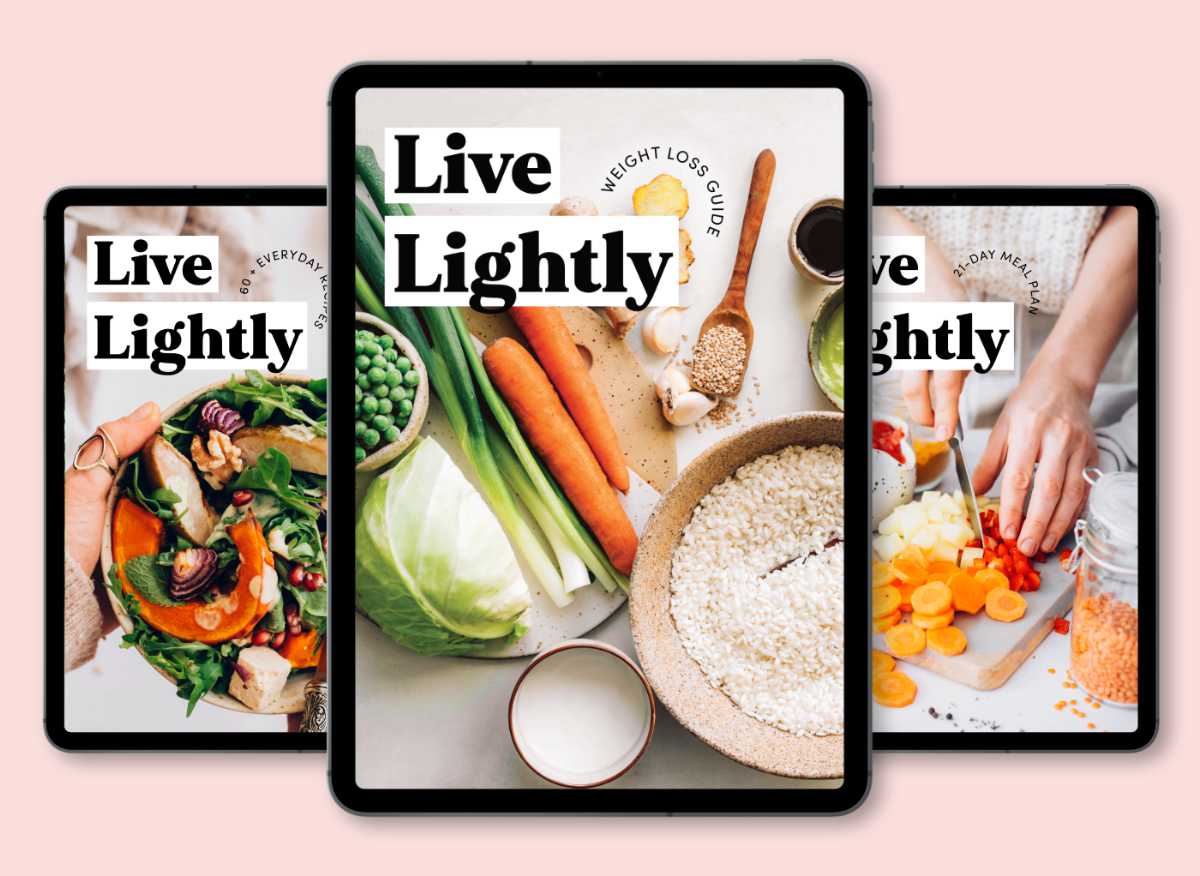
Vegan Weight Loss eBooks
Eat tasty meals in abundance without stressing about portions and calories! With our vegan eBook bundle “Live Lightly,” you’ll be on the fast lane to easy and sustainable weight loss. Here’s what’s inside:
- Starter Guide: weight loss-friendly food lists, understanding calorie density, easy meal creation, real-life tips, and much more
- 60 delectable recipes from breakfast to dinner and dessert
- 21-day weight loss meal plan with shopping lists and nutritional information

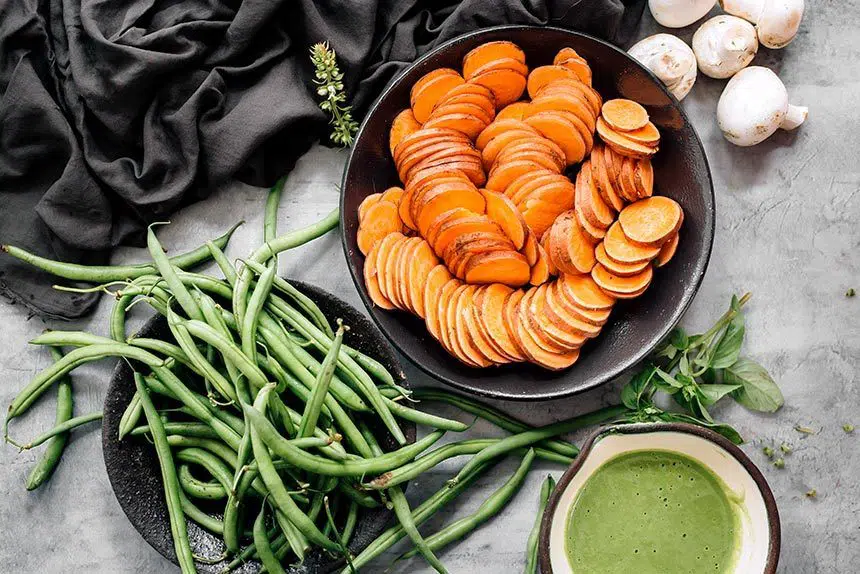
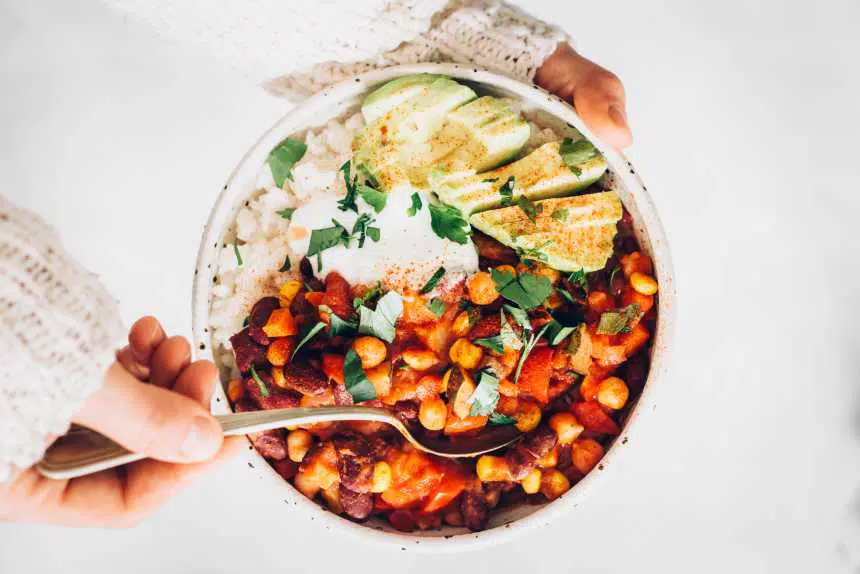
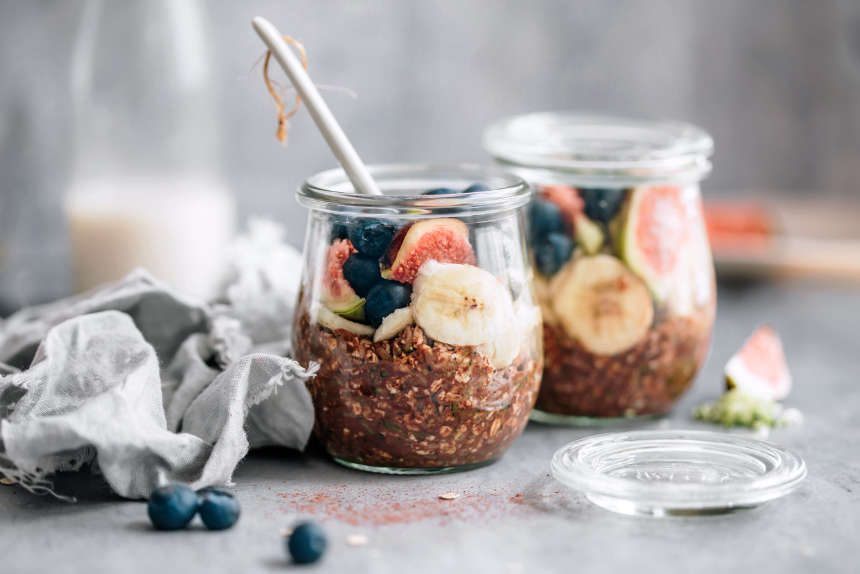
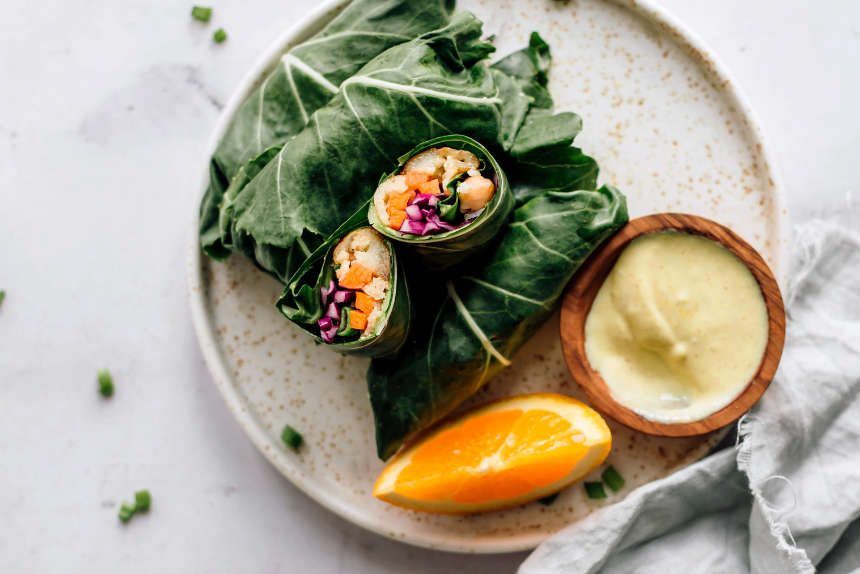
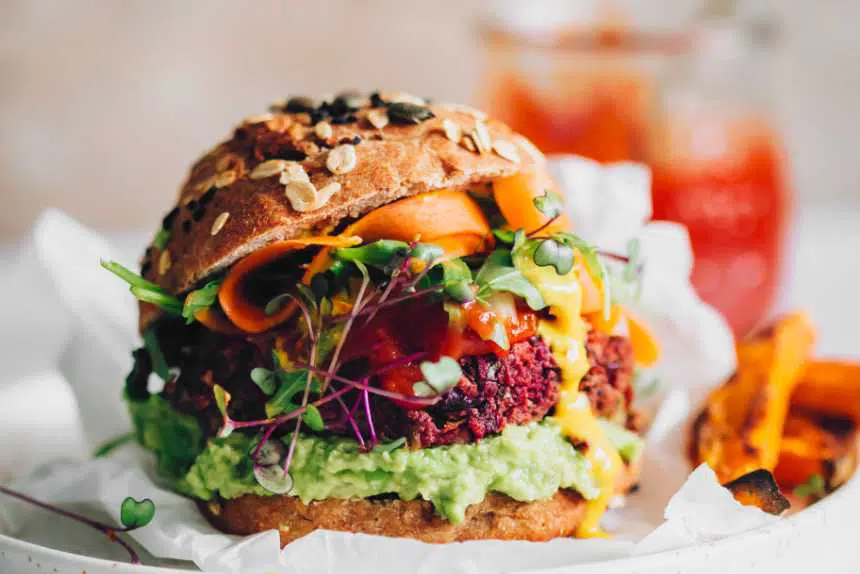
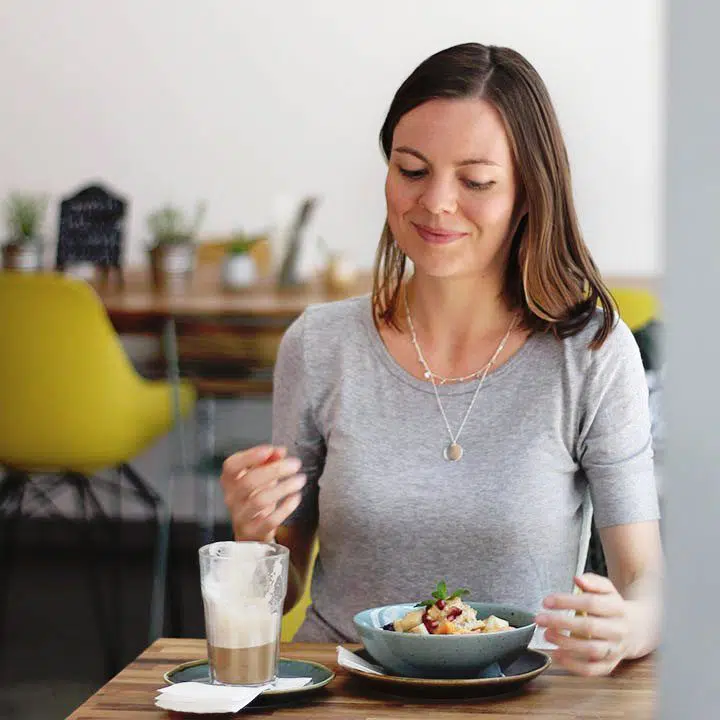
 Alena Schowalter is a Certified Vegan Nutritionist who has been a vegetarian since childhood and vegan since 2012. Together with her husband, she founded nutriciously in 2015 and has been guiding thousands of people through different transition stages towards a healthy plant-based diet. She’s received training in the fields of nutrition, music therapy and social work. Alena enjoys discussions around vegan ethics, walks through nature and creating new recipes.
Alena Schowalter is a Certified Vegan Nutritionist who has been a vegetarian since childhood and vegan since 2012. Together with her husband, she founded nutriciously in 2015 and has been guiding thousands of people through different transition stages towards a healthy plant-based diet. She’s received training in the fields of nutrition, music therapy and social work. Alena enjoys discussions around vegan ethics, walks through nature and creating new recipes.
Have you heard of calorie density before and have you experimented with it? Share with us in the comments below.